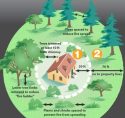As wildfires in the foothills increase in frequency and intensity, it behooves homeowners and gardeners to design and maintain their landscapes to be more fire resistant.
To work toward a more fire-safe landscape around your home, consider these three things: creating “defensible spaces,” selecting plants and garden materials that are more fire resistant, and grooming the landscape to reduce flammable vegetation and yard waste.
Defensible Space
The California Public Resources Code identifies two zones around a home that require smart planning relative to fire safety: the “home defense zone” and the “reduced fuel zone.” In the home defense zone, which extends 30 feet from the house, the code recommends removing or reducing the number of trees, shrubs and highly flammable materials (like dead vegetation and wood-chip mulches). The reduced fuel zone extends beyond the home defense zone an additional 70 feet, and is an area where trees and shrubs should be thinned out per specific guidelines, depending on slope and wind conditions (see “Home Landscaping for Fire,” Publication 8228, on the University of California Division of Agriculture and Natural Resources website here.
In the ANR catalog mentioned above, the objectives of the home defense zone are to:
- Maintain high moisture content in the vegetation.
- Decrease plant fuel density by increasing space between the branches.
- Shorten plant height.
- Create and maintain proper spacing between plants and the home.
- Remove combustible materials (such as firewood, twigs, needles and leaves, dry or cured grasses, shrubs, woodpiles, building materials, cardboard boxes and solvents) within 30 feet of the home, garage, outbuildings, and propane or other fuel tanks.
Plant Choices
While all plants will burn in the worst conditions, there are some that are more fire resistant than others. Generally speaking, plants with higher moisture content, like succulents and well-watered bedding plants, aren’t as flammable. Also, deciduous trees and shrubs tend to have higher moisture content when in leaf than do evergreens. Avoid situating resinous vegetation like pines, spruces, firs and junipers close to the house, as they are highly flammable.
Ground covers and low-growing bedding plants are recommended for the home defense zone, as are nonflammable gardening materials such as stone, gravel and pavers. Shrubs and specimen trees are fine, as long as they are spaced properly and aren’t planted so close to taller, more flammable trees that they effectively provide a “fuel ladder” for fire.
Pruning and Cleanup
Most wildfires start as surface fires, so proper tree and shrub pruning, as well as yard cleanup, goes a long way to prevent the spread of flames. Prune tree branches, particularly the resinous conifers, at least 15 feet from the ground. Trim trees at least 10 feet from a chimney. Cut back any dead tree branches that hang over your house or garage. All around your landscape remove dead, dry branches, twigs and tall weeds. If you compost leaf litter, position the piles outside the home defense zone and at a distance from flammable trees and shrubs.
Fall is not only a great time for garden grooming and planting, it’s also a good time to think about how you might redesign your landscape to minimize the risk of fire.
Rachel Oppedahl is a University of California Cooperative Extension Master Gardener of Tuolumne County.
UCCE Master Gardeners of Tuolumne County can answer home gardening questions. Call 209-533-5912 or go to: http://ucanr.edu/survey/survey.cfm?surveynumber=7269 to fill out our easy-to-use problem questionnaire. Check out our website at: http://cecentralsierra.ucanr.edu/Master_Gardeners/ You can also find us on Facebook, or pick up the local Master Gardener book “Sharing the Knowledge: Gardening in the Mother Lode” at Mountain Books or the UCCE Office both in Sonora, CA.


